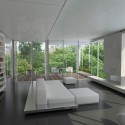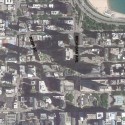Culver House Development / Dirk Denison Architects
The recent recipient of the 2010 AIA Chicago Unbuilt Design Award, the Culver House Development sparks the conversation of sustainable design within the private sector of the prestigious Gold Coast neighborhood, Chicago, Illinois. A mixed-use development, the building was designed to achieve LEED Gold status. Both the office space and eight dwelling units capitalize on the thoughtful design of the energy efficient and ample day-lit spaces.
The jurors are quoated as descirbing the Culver House Development plan as "very smart" and the scheme "handsome." In reference to the varied floor plans of the residential units jurors claimed that "it breaks the typical pattern of every floor being the same" and continuing stating, "it is like a jigsaw puzzle."
Architects: Dirk Denison Architects
Location: Chicago, Illinois, United States
Project Year: UnbuiltRenderings: Antonio Petrov , Daniel Wolf
Location: Chicago, Illinois, United States
Project Year: UnbuiltRenderings: Antonio Petrov , Daniel Wolf
The Culver House demonstrates a green development initiative in an urban context; conceived and designed to provide generous and diverse space for living and working, the building is configured with varied plans and sections, providing a series of unique spaces. The design uses dynamic spatial arrangements, light and greenery as its architectural vocabulary. The building is planned as a sustainable mixed-use development: one commercial space occupies the ground floor and eight residences populate the second through sixth floors. The ultimate goal of Culver House is to push the envelope of green design strategies in a private mixed-use project, ultimately raising the bar for future developments throughout the city and region.
The project seeks to expand the high-profile environmentally-conscious endeavors of the city government into the private sector, taking publicized city initiatives like green roofs and optimized energy performance to new levels and offering these features as amenities for the buildingʼs residents. The project rethinks an under-utilized site in a vibrant area of the city directly across from historic Washington Square Park. The design seeks to utilize existing infrastructure; as such, a small existing warehouse building on the site is kept largely intact and reused while the new portion of the building is built in front of and above it. This allows the design team to maximize the siteʼs density without compromising the utility of the existing structure. In addition to the park, the location offers future tenants access to stores, schools, restaurants, civic and cultural amenities, as well as various forms of public transportation all within a short walk.
The design process of the project represented a true collaborative effort, a fact that is evident in the innovative nature of its components. The proposed building uses the latest in green construction methods and the highest quality eco-sensitive and local materials. It is sited with its long axis running east-west allowing the utilization of southern light, especially above the third floor. The design team selected a high-performance Low-E glass curtain wall as the primary cladding material. The facades adjust to optimize the benefits of their orientation by the implementation of thermal mass walls as well as both interior and exterior planted spaces to buffer the interior from Chicagoʼs famously cold winters and hot and humid summers.
During the design process, the team collaborated in developing unique and innovative spaces to optimize thermal control: these green spaces function as "buffer zones" that essentially allow the expansion and occupation of a double-skinned façade at critical points along its length. The spaces function as winter gardens that can be fully opened to the favorable outside weather or fully closed to create a tempered space in the less desirable weather. In addition to these dynamic spaces, exterior terraces provide shading as well as a direct connection for the residents to the exterior and the park beyond. While the glass façade literally reflects its park-like setting, the greenery that is embedded in front of and within the building skin expands the adjacent park into the building itself.
Deciduous greenery shades the sun-exposed sides of the building in the hot summer months while allowing the lower winter sun to warm the cast-in-place concrete slab floors. At the same time, the verdant plantings become a tangible part of the everyday lives of the building residents, allowing for both physical and psychological benefits. In short, a keen attention to the building performance spurred the development of unique spaces within the units that transcend their seemingly functional nature, becoming real amenities for residents and creating a three-dimensional landscape intertwining interior and exterior spaces.
In addition to the winter garden green spaces, the building utilizes a green roof planted with native species as an amenity for residents that simultaneously serves as a small urban eco-system, cleaning the air and reducing the heat-island effect. Moreover, the roof collects rainwater to irrigate all of the green spaces throughout the building, lessening the impact storm sewers and cutting the potable water use of the development. Potable water use reduction is also achieved through by utilizing water-saving plumbing fixtures planned throughout the building.
Other building amenities include high-efficiency mechanical systems utilizing the concrete floor slabs in a zoned radiant heating system. Fresh air will come largely from operable windows and winter garden spaces, but this will be supplemented with an efficient forced-air system that utilizes heat-recovery technology to provide interior spaces with fresh air during the parts of the year when the winter gardens must remain closed. Optimized daylighting techniques serve to reduce energy consumption with all spaces planned to utilize natural light; artificial lighting is planned to exceed ENERGY STAR standards. Highly energy- and water-efficient appliances are planned for the unit interiors and building tenants will be encouraged to participate in a green energy program that purchases building energy needs from renewable sources. Residents will also be provided with a central bicycle storage room and will incorporate an extensive recycling program for both its residential and commercial tenants. Construction techniques are planned to manage and reduce wastes associated with the building process. Upon completion, and in order to supplement these extensive measures, a tenant awareness and training program will educate the residents on how the building functions so that they can fully utilize the sustainable features of the building.
The design for the Culver House development serves as a model for private sustainable mixed-use development in Chicago and strives to exceed standard green building practices. By utilizing tried-and- true sustainable techniques together with innovative new ideas for dynamic spaces that can regulate the interior environment of the building, the project pushes the boundaries of energy-saving techniques while at the same time using these design strategies as amenities for the buildingʼs residents. It is this critical marriage of function and amenity that the design team hopes will act as a model for future developments, recasting sustainable building techniques from a mere checklist to a completely integrated design strategy.
- Courtesy of Dirk Denison Architects
- Courtesy of Dirk Denison Architects
- Courtesy of Dirk Denison Architects
- Courtesy of Dirk Denison Architects
- Courtesy of Dirk Denison Architects
- Courtesy of Dirk Denison Architects
- Courtesy of Dirk Denison Architects
- Courtesy of Dirk Denison Architects
- Courtesy of Dirk Denison Architects
- buffer zone diagram
- garden diagram
- green systems diagram
- model
- floor plans
- aerial photograph
Dr. EMAD H. ISMAEEL
University of Mosul
Mosul - Iraq
Web Site: http://sites.google.com/site/emadhanee/
Tel : +964 (0)770 164 93 74



























تعليقات
إرسال تعليق